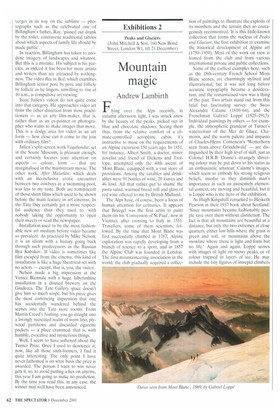Exhibitions 2
Peaks and Glaciers (John Mitchell & Son, 160 New Bond Street, London Wl. till 21 December)
Mountain magic
Andrew Lambirth
Flying over the Alps recently, in autumn afternoon light, I was struck anew by the beauty of the peaks, picked out in blue and chocolate shadows. Seeing them thus, from the relative comfort of a climate-controlled aeroplane cabin, it's instructive to muse on the requirements of an Alpine excursion 150 years ago. In 1851, for instance, Albert Smith, a doctor, minor novelist and friend of Dickens and Trollope, attempted only the 40th ascent of Mont Blanc, equipped with a vast store of provisions. Among the eatables and drinkables were 91 bottles of wine, 20 loaves and 46 fowl. All that rather put to shame the pasta salad, warmed bread roll and glass of red wine offered to me by British Midland.
The Alps have, of course, been a focus of human attention for centuries. It appears that Bruegel was the first artist to paint them (in his 'Conversion of St Paul', now in Vienna), after crossing to Italy in 1551. Travellers, some of them scientists, followed. By the time that Mont Blanc was first successfully climbed in 1787, Alpine exploration was rapidly developing from a branch of science to a sport, and in 1857 the Alpine Club was founded in London. The first mountaineering association in the world, the club graduallv acquired a collec tion of paintings to illustrate the exploits of its members and the terrain they so courageously reconnoitred. It is this little-known collection that forms the nucleus of Peaks and Glaciers, the first exhibition to examine the historical development of Alpine art (1750-1950). Most of the work on view is loaned from the club and from various international private and public collections.
Some of the earliest examples here, such as the 18th-century French School Mont Blanc scenes, are charmingly stylised and illustrational, but it was not long before accurate topography became a desideratum, and the romanticised view was a thing of the past. Two artists stand out from this brief but fascinating survey: the Swiss Alexandre Calame (1810-64), and the Frenchman Gabriel Loppe (1825-1913). Individual paintings by others — for example, the atmospheric grandeur of Turner's watercolour of the Mer de Glace, Chamonix, and the warm palette and impasto of Charles-Henri Contencin's `Wetterhorn seen from above Grindelwald' — are distinguished by their high level of skill, just as Colonel H.R.B, Donne's strangely shivering colour may be put down to his status as an enthusiastic amateur. Calame's images, which seem to embody his strong religious beliefs, insofar as they diminish man's importance in such an awesomely elemental context, are moving and beautiful, but it is Loppe who is the hero of the exhibition.
As Hugh Kingsmill remarked to Hesketh Pearson in their 1937 book about Scotland: 'Since mountains became fashionable people rave over them without distinction. The fact is that all mountains are beautiful at a distance, but only the two extremes at close quarters, either low hills where the grass is green and soft, or mountains above the snowline where there is light and form but no life.' Again and again, Loppe scores with images of light on snowy peaks, or of colour trapped in layers of ice. He may include the tin ; figures of intrepid climbers
to give a sense of scale, but the landscapes he is so expert at depicting under different light conditions are effectively lifeless wastes of snow and ice.
Loppe has been called the first artist with the soul of a mountaineer, but this accolade could readily be re-bestowed today on a painter currently showing canvases of the Nepalese Himalayas. Julian Cooper (born 1947) has lived for much of his life among the mountains of the Lake District, but has travelled far in order to come to grips with how to paint what the climber sees and feels. Cooper made an exploratory trip in 1995 to the Peruvian Andes and carried with him large canvases on which to work on site in high positions. In autumn 1999 he travelled to the Kanchenjunga region of Nepal, in order to take his researches further. The Andean trip had taught him that in front of the motif there was almost too much information to process and record. At Kanchenjunga, he decided to concentrate on making small painted studies and taking photographs — the real work would be done back in his studio in England.
In fact, Cooper found that the small studies done in situ captured something of the actual flavour of being on the mountain. Meanwhile the larger, more abstract recreations of the vertical faces of the mountain explored the fall of light on the shifting forms of snow and rock with a wonderful freedom echoed in the run of
paint and the slab of impasto. These latest triumphs of mountaineering art can be seen at The Wordsworth Trust, Dove Cottage, Grasmere, until 7 April 2002, after which a selection will be on show at Art Space Gallery, 84 St Peter's Street, London Ni, in June and July.























































































 Previous page
Previous page